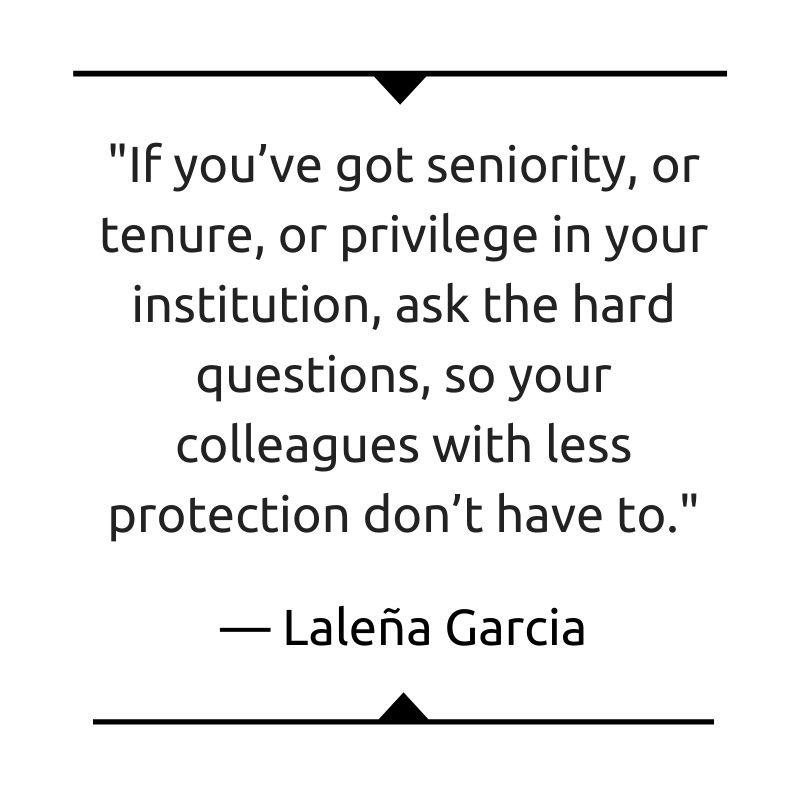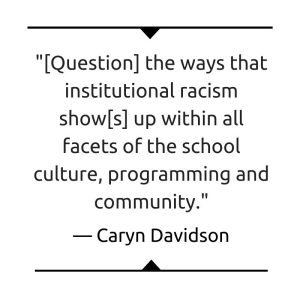What We Believe: A Black Lives Matter Activity Book is a collaboration between Laleña Garcia and Caryn Davidson, both professional educators and activists with the Black Lives Matter at Schools NYC organizing group. Learn the story behind What We Believe here and how the author and illustrator define activism and allyship in the first two installments.
Today, in the third installment of our conversation, Laleña and Caryn share tips and suggestions for educators who face institutional opposition when bringing learning about BLM, social justice, and activism into their classrooms:
What advice would you give educators who want to start social justice initiatives in their schools, but face opposition? And how can parents use their voices to support this work?
Laleña Garcia: I have to say, I get asked this question all the time, and it makes me so sad. Not that people want to be involved with social justice, but that they face opposition. Why are people against justice? I mean, I know why, but it’s appalling to me the number of people who will say it straight out.
I encourage parents and teachers to find community organizations that are already doing the work; there’s no need to re-create the wheel, and split resources. You’ll have to do research — on the internet, on the ground in the community you’re in (hopefully that’s where you’re trying to create change), with folks who are similarly engaged — but it’s really important to make sure you’re not coming in with, “I have a great idea that no one has had before!” and stomping all over the toes of people with less power and privilege who have been working on this for years.
In schools, one strategy is to find the school’s mission statement, and see if there’s any language in it about kids being global citizens or making the world a better place or believing in all children’s potential; if you can connect the work you’d like to do with your school’s mission statement, then you have a really good place to start from: it’s hard for schools to say, “Nope, we just have that in our mission statement, we don’t really believe it.”
Build from what you have. When I first started teaching the principles, I always told people to start with the “easy” ones, like empathy, restorative justice, and diversity. “Of course you’re teaching empathy in an early childhood classroom,” I’d tell them. “That’s exactly what you’re supposed to be doing, and no one will look you in the face and say, ‘But I don’t want my child to learn how to care about how other people feel.’” Make choices about the books you use, the materials you offer, and the conversations you have within your existing curriculum.
 Caryn Davidson: It is so important to connect with people in your school community who share critical concerns and are truly committed to centering ongoing anti-racist work. There are many reasons why teachers hesitate to take initiative in uplifting and supporting Black lives in their schools – including their colleagues and students – and these relate to the specific school culture and power dynamics at play. Untenured teachers may fear speaking up; white teachers may be worried about taking up too much space; white teachers may be complicit in various explicit and implicit aspects of white supremacy culture in their school; and there are all kinds of institutional and interpersonal reasons why BIPOC teachers may not be able or willing to be critically vocal and at the forefront of social justice initiative or action.
Caryn Davidson: It is so important to connect with people in your school community who share critical concerns and are truly committed to centering ongoing anti-racist work. There are many reasons why teachers hesitate to take initiative in uplifting and supporting Black lives in their schools – including their colleagues and students – and these relate to the specific school culture and power dynamics at play. Untenured teachers may fear speaking up; white teachers may be worried about taking up too much space; white teachers may be complicit in various explicit and implicit aspects of white supremacy culture in their school; and there are all kinds of institutional and interpersonal reasons why BIPOC teachers may not be able or willing to be critically vocal and at the forefront of social justice initiative or action.
It is unsustainable for only one individual to fight for something that requires a full school cultural shift; but as the quote goes, “If you are neutral in situations of injustice, you have chosen the side of the oppressor.” There is no neutrality when it comes to racism; there is no such thing as being not racist, as Ibram X. Kendi says. And if one is actually anti-racist – as opposed to participating in racist structures and practices – then they must take action; such benefits ALL members of the community equally (white and BIPOC families, students, teachers, administrators). Once you do take action, you will find other colleagues slowly (or readily) stepping up, and you will find (if not create) spaces to connect with parents and students; it takes prioritizing coalition-building amongst all community stakeholders.
 White teachers can use their white privilege, model what active anti-racism can look and feel like, and build meaningful relationships with their BIPOC colleagues when they offer their full truth and energy to the work. Parents should always ask whoever they are connected to within the school – their kids, administrators and teachers – where the social justice, anti-racist and culturally responsive work is happening, and figure out how parents can support that work. Parents can form equity groups or use their PA or PTA to question the ways the school is or is not decentering whiteness (no matter the demographic makeup of the school), and whether it is or is not fully admitting and rectifying the ways that institutional racism show up within all facets of the school culture, programming and community.
White teachers can use their white privilege, model what active anti-racism can look and feel like, and build meaningful relationships with their BIPOC colleagues when they offer their full truth and energy to the work. Parents should always ask whoever they are connected to within the school – their kids, administrators and teachers – where the social justice, anti-racist and culturally responsive work is happening, and figure out how parents can support that work. Parents can form equity groups or use their PA or PTA to question the ways the school is or is not decentering whiteness (no matter the demographic makeup of the school), and whether it is or is not fully admitting and rectifying the ways that institutional racism show up within all facets of the school culture, programming and community.
LG: As Caryn says, find your accomplices in your colleagues; who else is doing this work? I also think it’s important, whenever you can (which won’t be always), to be loud when you face opposition. “Wait, are you saying this school doesn’t believe in giving kids another chance to make a better choice? Are you saying that if I’m teaching literature I can’t use books with Black children and by Black authors?” or whatever ridiculousness you’re facing. If you’ve got seniority, or tenure, or privilege in your institution, ask the hard questions, so your colleagues with less protection don’t have to. (P.S. This is another great way to be an ally.)
 Laleña Garcia has taught in New York City early childhood education programs for more than twenty years. What We Believe grew out of her work with Black Lives Matter in Schools, a teachers’ organization striving for racial equity in education, and she has presented at local and national conferences on teaching the principles of the BLM movement to children. A graduate of Yale University and the Bank Street College of Education, she lives in Brooklyn, NY. Please visit her website at rootedkids.org and follow her on Instagram at @blm_in_kindergarten.
Laleña Garcia has taught in New York City early childhood education programs for more than twenty years. What We Believe grew out of her work with Black Lives Matter in Schools, a teachers’ organization striving for racial equity in education, and she has presented at local and national conferences on teaching the principles of the BLM movement to children. A graduate of Yale University and the Bank Street College of Education, she lives in Brooklyn, NY. Please visit her website at rootedkids.org and follow her on Instagram at @blm_in_kindergarten.
 Caryn Davidson studied Anthropology and Visual Art at Brown University and received her MA in Arts Education from NYU. Since the start of her career in education in 2004, she has founded and developed the arts programs at three public schools in New York City, and led initiatives to promote culturally relevant pedagogy and socially just practices within those school communities. She now teaches art at the high school level in Brooklyn, NY, where she also lives. She is a Steering Committee member of the Black Lives Matter at NYC Schools organizing group and a designer for the national Black Lives Matter at Schools movement. Please visit her website at caryndavidson.com and on Instagram at @caryn_arts.
Caryn Davidson studied Anthropology and Visual Art at Brown University and received her MA in Arts Education from NYU. Since the start of her career in education in 2004, she has founded and developed the arts programs at three public schools in New York City, and led initiatives to promote culturally relevant pedagogy and socially just practices within those school communities. She now teaches art at the high school level in Brooklyn, NY, where she also lives. She is a Steering Committee member of the Black Lives Matter at NYC Schools organizing group and a designer for the national Black Lives Matter at Schools movement. Please visit her website at caryndavidson.com and on Instagram at @caryn_arts.









